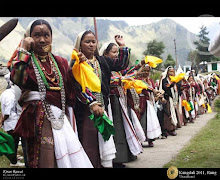Sapa is a former French Colonial Hill station situated amongst the highest mountain ranges of Vietnam, Hoang Lien Son near the Chinese border. Sapa Valley remains one of Vietnam’s most enchanting sights. Sapa is popular for its unmatched scenery, pristine environment, cool climate and a range of hill-tribes people who reside in the area. Sapa offers a number of adventure outdoor activities, camping, trekking and cycling are the most popular of these. It is rich with natural sites like Silver Waterfall, Ham Rong Mountain, Bamboo Forest, Rattan Bridge, and Ta Phin Cave.
These tribes have their own culture and most of the local and foreign tourists enjoy learning about their ways of life, through taking a tour or organizing an overnight home-stay. If you visit them, you’ll learn about their farming techniques and how they make their garments. You will also be treated to the traditional hill-tribe music, a captivating experience that will allow you to submerge yourself in how easy life can be!
Love Market only takes place each Saturday night; hence if you need to experience the popular Sapa custom, extend your stay to Saturday night. The best season for trekking is between March to May and September to December. If you visit Sapa during January and February, expect it to be cold. Sapa is about 1500m above sea level hence the weather is cold at night.
The Hmong culinary specialty that you might want to eat is Thang Co Blood Porridge, prepared from a blend of goat meat and pony, cooked slowly to produce fine soup served in the big hot-pot. This food is one of the most popular staple of the locals and is shared by everybody, using traditionally made chopsticks to dip the meat into a spicy dip, usually accompanied with bread, vegetables and herbs. It’s good to try this dish at one of the many eateries in Sapa, as opposed to one of the markets.
 |
| Paddy Plantations in the SAPA Valley |
The History of Sapa
Sapa was located by Jesuit missionaries in the year 1918. He was lured by a cool climate. Western arrivals soon turned the town into a hill station. They constructed the church, tennis courts, hotels, an airport, summer villas, and hydro-electric station. Many were deserted or ruined during the war for independence, but some of the colonial influence remains.The People
Sapa is home to a wealth of colorful, varied hill-tribes who have resisted integration into the modern life. Actually, the hill tribes, incorporating the Dao, the Hmong, and the Dai, comprise the majority of the inhabitants in the region, outnumbering Vietnamese who have conventionally preferred warmer climate of low lands. They are the attraction of the area, putting on traditional dress of hand woven as well as silver jewellery. They are a bit introvert and are wary of the foreigners.These tribes have their own culture and most of the local and foreign tourists enjoy learning about their ways of life, through taking a tour or organizing an overnight home-stay. If you visit them, you’ll learn about their farming techniques and how they make their garments. You will also be treated to the traditional hill-tribe music, a captivating experience that will allow you to submerge yourself in how easy life can be!
The Climate
Sapa can be explored virtually all year-round from the month of March to early December. In fact, the locals would love to visit Sapa in June and July in order to flee from summer in other parts of Vietnam. During the day, the average temperature in Sapa is approximately 15-18° C. The best time of the week to visit Sapa is the weekday since the weekend is always busy with many people coming to the place.Love Market only takes place each Saturday night; hence if you need to experience the popular Sapa custom, extend your stay to Saturday night. The best season for trekking is between March to May and September to December. If you visit Sapa during January and February, expect it to be cold. Sapa is about 1500m above sea level hence the weather is cold at night.
Things to Do
The most notable site in Sapa is its central market. It is the main gathering place for the hill-tribes from the nearby villages. Hill-tribes assemble there not just to sell jewelry, handicrafts, orchids, honey and mushrooms, but also to cultivate relations with other tribe. On some evenings, singing, courtships as well as marriages take place. Diversions comprise hiking to the nearby villages where it’s possible to stay overnight, 3 day scaling of Fansipan and Silver Falls a few kilo meters north. Highlights incorporate the highest paved pass in Vietnam, an assortment of hill-tribe villages, and exploration of Sapa’s mountain tranquil surroundings. |
| Sapa Stree Food |
What to Eat
The Hmong culinary specialty that you might want to eat is Thang Co Blood Porridge, prepared from a blend of goat meat and pony, cooked slowly to produce fine soup served in the big hot-pot. This food is one of the most popular staple of the locals and is shared by everybody, using traditionally made chopsticks to dip the meat into a spicy dip, usually accompanied with bread, vegetables and herbs. It’s good to try this dish at one of the many eateries in Sapa, as opposed to one of the markets.



0 comments:
Post a Comment